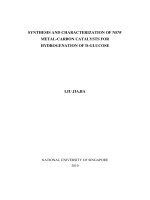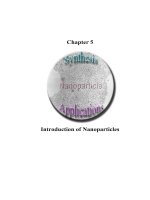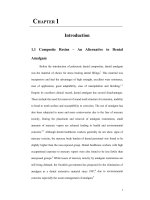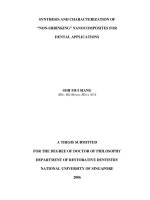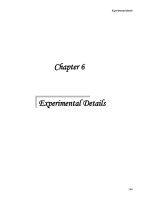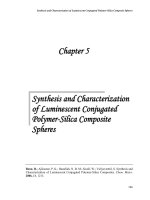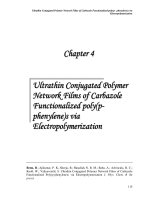Synthesis and characterization of new (E)-N’-(substituted benzylidene)-2-(3-(2- methyl)-4-oxo-3,4-dihydroquinazolin-2-ylthio)acetohydrazides
Bạn đang xem bản rút gọn của tài liệu. Xem và tải ngay bản đầy đủ của tài liệu tại đây (1.64 MB, 13 trang )
Turk J Chem
(2014) 38: 275 287
ă ITAK
c TUB
Turkish Journal of Chemistry
/>
doi:10.3906/kim-1306-20
Research Article
Synthesis and characterization of new (E)-N-(substituted benzylidene)-2-(3-(2methyl)-4-oxo-3,4-dihydroquinazolin-2-ylthio)acetohydrazides
2
ă
Aamer SAEED1,, Shams-ul MAHMOOD1 , Ulrich FLORKE
Department of Chemistry, Quaid-I-Azam University, Islamabad, Pakistan
2
Department of Chemistry, Faculty of Natural Sciences, University of Paderborn, Paderborn, Germany
1
Received: 10.06.2013
•
Accepted: 13.09.2013
•
Published Online: 14.03.2014
•
Printed: 11.04.2014
Abstract: A small library of new azomethine derivatives of 3-aryl-2-thioxo-2,3-dihydroquinazolin-4(1 H) -ones was synthesized. The key intermediates 2-thioxo-quinazolinones (3a–e), obtained in 2 steps from the corresponding anilines,
were treated with methyl chloroacetate to afford S-substituted esters (4a,d), which were then converted into corresponding acetohydrazides (5a,d). Further, acetohydrazide (5d) was converted to the azomethines derivatives (6a–k)
by reacting with a number of suitably substituted benzaldehydes. FTIR,
1
H NMR,
13
C NMR, GC-MS, and elemental
analyses were used to confirm the assigned structures of the synthesized compounds. Further, compounds 3a, 5, and 6j
were also confirmed by X-ray diffraction data.
Key words: Synthesis, crystal structures, 3,4-dihydroquinazolines, acetohydrazides, azomethines
1. Introduction
Quinazolinone is one of the leading and flourishing structures in medicinal chemistry. Quinazolinone derivatives
display a wide range of biological and pharmacological activities such as anticonvulsant, anti-inflammatory,
antitumor, analgesic, anticancer, cytotoxic, anticoccidial, antibacterial, and antifungal. 1−10 Moreover, quinazolinone derivatives are effectively used as inhibitors of human microsomal prostaglandin synthase 1 (mPGES
1) 11 and a potential PET tracer for growth hormone secretagogue receptor (GHSR). 12 3-Aryl-2-thioxo-2,3dihydroquinazolin-4(1 H) -ones are a very important subclass of quinazolinones having a diversity of pharmacological and biological activities like anticonvulsant, 13 5-HT 2A receptor antagonistic, 14 antitumor, 15 antimicrobial, 16 anticancer, 17,18 antimicrobial, 19 analgesic, and anti-inflammatory. 20 On the other hand, hydrazides,
hydrazones, or azomethines are of wide interest because of their diverse synthetic, biological, and clinical
applications, 21−28 e.g., antimalarial, antiparasitic, antimicrobial, anticonvulsant, and antituberculosis activity.
Herein, we report the synthesis of new hydrazone derivatives of S-linked quinozolines with a number of
substituted benzaldehydes in an attempt to obtain compounds with enhanced bioactivities.
2. Results and discussion
The synthesis of 3-aryl-2-thioxo-2,3-dihydroquinazolin-4(1H)-one (3a–e) was carried out according the synthetic route shown in Scheme 1 involving treatment of substituted anilines with carbon disulfide and sodium
hydroxide in dimethyl sulfoxide to afford sodium dithiocarbamates (2). Quinazolin-4(1H)-ones (3a–e) were
∗ Correspondence:
275
SAEED et al./Turk J Chem
obtained by adding methyl anthranilate to the solution of the latter in ethanol using anhydrous potassium
carbonate as a weak base.
O
OCH3
R
CS2
NH2
(1)
NaOH
DMSO
R
S
NH2
NH
Me2SO4
SCH3 C2H5OH / K2CO3
(2)
O
R
N
N
S
H
(3a-e)
3a R= 2-CH3
3b R= 4-CH3
3c R= 2-OCH3
3d R= 4-OCH3
3e R= 4-Cl
Scheme 1. Synthetic route to 3-aryl-2-thioxo-2,3-dihydroquinazolin-4(1 H) -ones (3a–e).
The FTIR spectra of 3a–e showed stretching vibrations at 3186–3189 cm −1 for NH, at 1702–1706 cm −1
for C=O, and at 1220–1225 cm −1 for C=S. In 1 H NMR the characteristic NH proton of the ring appeared in
the range of 13.02–11.80 ppm and the aromatic protons at 8.10–6.99 ppm.
Figure 1 shows the molecular structure of 3-o-tolyl-2-thioxo-2,3-dihydroquinazolin-4(1H)-one (3a), while
the crystal packing is shown in Figure 2. The crystal packing of 3a with 2 crystallographically independent
˚ and N22–H. . . O2(–x, y –
molecules A and B shows N12–H. . . O1(–x + 1, y + 0.5, –z + 1.5) with H. . . O 2.35 A
0.5, –z + 0.5) with H. . . O 1.95 ˚
A interactions that link molecules into endless chains extended along the b-axis
(Figure 2). The aromatic planes of the molecules are twisted along the N–C axes and make dihedral angles of
77.1(2) ◦ for molecule A and 79.0(2) ◦ for B. In general, there are no unexpected geometric parameters.
Figure 1. Molecular structure of 3a (both molecules A and B) with displacement ellipsoids plotted at 50% probability
level.
276
SAEED et al./Turk J Chem
Figure 2. Crystal packing pattern of 3a with hydrogen bonds as dotted lines. H-atoms not involved are omitted.
The quinazolinones (3a–e) were converted to corresponding esters (4a,d) by treating with methyl
chloroacetate in ethanol using a catalytic amount of anhydrous potassium carbonate. In the case of 4a, the
NH absorption disappeared and ester carbonyl stretching in the range of 1730–1733 cm −1 in the FTIR spectrum indicated ester formation.
1
H NMR confirmed the formation of quinazolinyl esters by the appearance of
methylene protons at 4.05–3.67 ppm as 2 separate doublets due to their diastereotopic nature. In 13 C NMR
the appearance of a signal in the range of 168.76–169.35 ppm for the C=O of ester, disappearance of the signal
for C=S, and the appearance of methylenic carbons in the range of 34.73–34.35 ppm were observed.
The acetohydrazides (5a,d) were obtained by treating the esters (4a,d) with hydrazine hydrate in
ethanol. In the case of 5a, characteristic absorption for primary NH 2 , along with a shoulder at 3420–3402
cm −1 and an absorption peak for secondary NH in the range 3239–3230 cm −1 , was observed in the FTIR. In
1
H NMR characteristic signals for N–H and NH 2 protons appeared in the regions 9.80–9.40 and 9.05–8.35 ppm,
respectively. In 13 C NMR the disappearance of methoxy protons of ester and the methoxy carbon signal was
noted. Figure 3 shows the molecular structure of 5a, while the crystal packing is shown in Figure 4.
The dihedral angle between the 2 aromatic ring planes is 85.51(6) ◦ , while the N4–C3–S1–C1 torsion
˚ and
angle measures 176.9(1) ◦ . Prominent D–H. . . A bonds are N1–H. . . O2(x – 1, y, z) with H. . . O 2.00 A
N2–H2B. . . O1(–x, –y + 1, –z) with H. . . O 2.15 ˚
A that link molecules into centro-symmetric dimers connected
along the a-axis (Figure 4).
Finally, the hydrazones (6a–k) were prepared for only the acetohydrazide (5d) by treating an ethanolic
solution of the latter with different substituted aromatic aldehydes using a catalytic amount of sulfuric acid.
In a typical case of 6a, disappearance of NH 2 stretching of hydrazides and appearance of stretching around
(Scheme 2) 1608–1602 cm −1 for C=N in FTIR indicated the formation of azomethine linkage. Appearance of
the azomethine protons in the range of 8.90–8.20 ppm in
C=N in
13
1
H NMR and the signal around 158–156 ppm for
C NMR spectra further confirmed the formation of the final compounds.
277
SAEED et al./Turk J Chem
Figure 3. Molecular structure of 5a with displacement ellipsoids plotted at 50% probability level.
Figure 4. Crystal packing pattern of 5a with hydrogen bonds as dotted lines. H-atoms not involved are omitted.
Figure 5 shows the molecular structure of the (E)-N’-(3,4,5-trimethoxybenzylidene)-2-(3-o-tolyl-4-oxo3,4-dihydroquinazo lin-2-yl thio)acetohydrazide (6j), while the crystal packing is shown in Figure 6.
In 6j, the dihedral angle between the 2 aromatic ring planes is 71.94(6) ◦ and the N4–C13–S1–C1 torsion
˚,
angle is 169.5(1) ◦ . Intermolecular hydrogen bond interactions N1–H. . . O100(x – 1, y, z) with H. . . O 1.97 A
O100–H100. . . O200(–x + 3, –y, –z) with 1.86 ˚
A, O200–H210. . . O1 with 1.98 ˚
A, and O200–H202. . . O3(x, –y –
0.5, z + 0.5) with 2.11 ˚
A link the water and the ethanol solvent moieties to the main molecule (Figure 6).
278
SAEED et al./Turk J Chem
O
Cl
N
O
CH3
R
N
DMF, K2CO3
S
N
H
O
O
O
R
N
OCH3
S
NH2NH2.H2O
R
N
N
C2H5OH
S
5a,d
(4a,d)
H3C
O
CHO
N
H
N
S
O
(5)
H3C
O
R'
N
NH2
N
C2H5OH / H+
reflux
NH2
O
O
(3a,d)
H
N
N
H
N
S
N
R'
O
(6a-k)
6a R'= 2-Br
6b R'= 3-Br
6c R'= 4-Br
6d R'= 2-Cl
6e R'= 3-Cl
6f R'= 4-Cl
6g R'= 3-NO2
6h R'= 4-NO2
6i R'= 3-OMe
6j R'= 3,4,5-OMe
6k R'= 2-OCH2C6H5
Scheme 2. Synthesis of ( E) -N’-(substituted benzylidene)-2-(3-o-tolyl-4-oxo-3,4-dihydroquinazolin-2-ylthio)acetohydrazides.
Figure 5. Molecular structure of 6j with displacement ellipsoids plotted at 50% probability level.
3. Experimental
Melting points were recorded using a digital Gallenkamp (SANYO) model MPD.BM 3.5 apparatus and are
uncorrected. 1 H NMR and 13 C NMR spectra were determined at 300 MHz using a Bruker AM-300 spectrophotometer. FTIR spectra were recorded on a Bio-Rad-Excalibur Series Mode FTS 3000 MX spectrophotometer.
279
SAEED et al./Turk J Chem
Mass spectra (EI, 70 eV) were obtained on a GC-MS (Agilent Technologies 6890N) and an inert mass selective detector (5973 mass spectrometer, Agilent Technologies) and elemental analyses were conducted using a
LECO-183 CHNS analyzer. Thin layer chromatography (TLC) was conducted on 0.25-mm silica gel plates (60
F254, Merck). Visualization of chromatograms was done with UV at 365 and 254 nm.
Figure 6. Crystal packing pattern of 6j with hydrogen bonds as dotted lines. H-atoms not involved are omitted.
General procedure for the synthesis of 3-aryl-2-thioxo-2,3-dihydroquinazolin-4(1H ) ones
(3a–e)
To a solution of substituted aniline (1) (0.02 mol) in DMSO (10 mL) was added carbon disulfide (1.6
mL, 0.026 mol) followed by an aqueous solution of sodium hydroxide (1.2 mL, 20 M) dropwise with stirring.
After 2 h dimethyl sulfate (0.02 mol) was added gradually and the reaction mixture was stirred in a freezing
mixture for 5 h. After completion, the reaction mixture was poured into ice water. The solid obtained was
filtered, washed, and recrystallized from ethanol to give methyl substituted phenylcarbamodithioate (2). To the
solution of 2 (0.01 mol) in ethanol (20 mL) methyl anthranilate (0.01 mol) and anhydrous potassium carbonate
(100 mg) were added and the reaction mixture was refluxed for 25 h. The reaction mixture was added to ice
cold water and a solid product was obtained. The solid obtained was filtered off and purified by dissolving in
10% alcoholic sodium hydroxide solution followed by further refluxing. After cooling at room temperature it
was re-precipitated by treating with dilute hydrochloric acid. The solid was obtained, washed with water, and
recrystallized from ethanol to give 3-aryl-2-thioxo-2,3-dihydroquinazolin-4(1H) -ones (3a–e).
3-o-Tolyl-2-thioxo-2,3-dihydroquinazolin-4(1H )-one (3a):
(80%): mp 245 ◦ C; R f : 0.20 (Petroleum ether:ethyl acetate 4:1); IR (Pure) υ : 3185–3189 (N–H), 1702–
1706 (C=O), 1583–1586 (Ar–C=C), 1220–1225 (C=S), cm −1 ;
1
H NMR (DMSO, 300 MHz) δ : 11.81 (s, 1H,
NH), 8.09 (d, 1H, Ar–H, J =8.1 Hz), 7.90 (m, 1H, Ar–H), 7.74–7.05 (m, 6H, Ar–H), 2.07 (s, 3H, C–H);
13
C
NMR (75 MHz) δ : 176.3 (C=S), 159.4 (C=O), 139.9 (Ar), 138.7 (Ar), 136.0 (Ar), 135.7 (Ar), 132.4 (Ar), 130.4
(Ar), 128.8 (Ar), 128.4 (Ar), 127.8 (Ar), 126.6 (Ar), 116.1 (Ar), 115.3 (Ar), 16.6 (C–H); Anal. Calcd. For
C 15 H 12 N 2 OS: C, 67.14; H, 4.51; N, 10.44; O, 5.96; S, 11.95; Found: C, 67.10; H, 4.48; N, 10.40; S, 11.90;
GC-MS m/z: 268.07 (M . +, 100).
280
SAEED et al./Turk J Chem
3-p-Tolyl-2-thioxo-2,3-dihydroquinazolin-4(1H )-one (3b):
(75%): mp 230 ◦ C; R f : 0.19 (Petroleum ether:ethyl acetate 4:1); IR (Pure) υ : 3185–3189 (N–H), 1705–
1710 (C=O), 1586–1590 (Ar–C=C), 1223–1237 (C=S), cm −1 ;
1
H NMR (DMSO, 300 MHz) δ : 12.10 (s, 1H,
NH), 8.10 (d, 1H, Ar–H, J =8.2 Hz), 7.80 (m, 1H, Ar–H), 7.76–6.99 (m, 6H, Ar–H), 2.07 (s, 3H, C–H);
13
C
NMR (75 MHz) δ : 175.3 (C=S), 159.4 (C=O), 139.8 (Ar), 138.7 (Ar), 136.0 (Ar), 135.7 (Ar), 132.4 (Ar), 130.4
(Ar), 128.8 (Ar), 128.8 (Ar), 127.8 (Ar), 127.8 (Ar), 116.1 (Ar), 115.3 (Ar), 16.6 (C–H); Anal. Calcd. For
C 15 H 12 N 2 OS: C, 67.14; H, 4.51; N, 10.44; S, 11.95; Found: C, 67.11; H, 4.49; N, 10.41; S, 11.91; GC-MS m/z:
268.07 (M . +, 100).
3-(2-Methoxyphenyl)-2-thioxo-2,3-dihydroquinazolin-4(1H )-one (3c):
(79%): mp 250 ◦ C; R f : 0.17 (Petroleum ether:ethyl acetate 4:1); IR (Pure) υ : 3186–3191 (N–H), 1703–
1707 (C=O), 1584–1589 (Ar–C=C), 122–1225 (C=S), cm −1 ;
1
H NMR (DMSO, 300 MHz) δ : 11.80 (s, 1H,
NH), 7.99 (d, 1H, Ar–H, J =8.1 Hz), 7.80 (m, 1H, Ar–H), 7.75–7.10 (m, 6H, Ar–H), 3.7 (s, 3H, C–H);
13
C NMR
(75 MHz) δ : 178.3 (C=S), 160.4 (C=O), 159.0 (Ar), 139.8 (Ar), 138.7 (Ar), 136.1 (Ar), 135.7 (Ar), 132.4 (Ar),
130.4 (Ar), 128.8 (Ar), 127.2 (Ar), 126.3 (Ar), 125.2 (Ar), 116.1 (Ar), 115.3 (Ar), 55.7 (C–O); Anal. Calcd. For
C 15 H 12 N 2 O 2 S: C, 63.36; H, 4.25; N, 9.85; S, 11.28; Found: C, 63.33; H, 4.22; N, 9.86; S, 11.24; GC-MS m/z:
284.06 (M . +, 100).
3-(4-Methoxyphenyl)-2-thioxo-2,3-dihydroquinazolin-4(1H )-one (3d):
(80%): mp 280 ◦ C; R f : 0.15 (Petroleum ether:ethyl acetate 4:1); IR (Pure) υ : 3187–3191 (N–H), 1704–
1708 (C=O), 1585–1590 (Ar–C=C), 1224–1227 (C=S), cm −1 ;
1
H NMR (DMSO, 300 MHz) δ : 13.02 (s, 1H,
NH), 7.95 (d, 1H, Ar–H, J =8.3 Hz), 7.75 (m, 1H, Ar–H), 7.54–7.00 (m, 6H, Ar–H), 3.8 (s, 3H, C–H);
13
C
NMR (75 MHz) δ : 176.8 (C=S), 160.4 (C=O), 159.1 (C–O, Ar), 139.9 (Ar), 136.0 (Ar), 132.4 (Ar), 130.4 (Ar),
127 (Ar), 124.7 (Ar), 116.6 (Ar), 116.1 (Ar), 114.5 (Ar), 55.7 (O–C); Anal. Calcd. For C 15 H 12 N 2 O 2 S: C,
63.36; H, 4.25; N, 9.85; O, 11.25; S, 11.28; Found: C, 63.31; H, 4.21; N, 9.83; S, 11.25; GC-MS m/z: 284.06
(M . +, 100).
3-(4-Chlorophenyl)-2-thioxo-2,3-dihydroquinazolin-4(1H )-one (3e):
(75%): mp 270 ◦ C; R f : 0.20 (Petroleum ether:ethyl acetate,4:1); IR (Pure) υ : 3189–3193 (N–H), 1705–
1710 (C=O), 1586–1590 (Ar-C=C), 1225–1230 (C=S), cm −1 ;
1
H NMR (DMSO, 300 MHz) δ : 11.80 (s, 1H,
NH), 8.10 (d, 1H, Ar–H,J =8.1 Hz), 7.80 (m, 1H, Ar–H), 7.78–6.98 (m, 6H, Ar–H);
13
C NMR (75 MHz) δ :
173.2 (C=S), 161.2 (C=O), 139.8 (Ar), 138.7 (Ar), 136.1 (Ar), 135.7 (Ar), 132.0 (Ar), 132.0 (Ar), 128.0 (Ar),
128.0 (Ar), 126.1 (Ar), 125.0 (Ar), 116.0 (Ar), 115.2 (Ar); Anal. Calcd. For C 14 H 9 ClN 2 OS: C, 58.23; H, 3.14;
N, 9.70; S, 11.10; Found: C, 58.20; H, 3.11; N, 9.67; S, 11.12; GC-MS m/z: 288.01 (M . +, 100).
General procedure for the synthesis of quinazolinyl esters (4a,d)
To a solution of quinazolinone (4a,d) (0.01 mol) in 15 mL of dimethylformamide were added methyl
chloroacetate (0.014 mol) and 5 g of K 2 CO 3 . The reaction mixture was heated on an oil bath for 2 h keeping
the temperature at 50 to 60 ◦ C, poured into ice-water, and allowed to stand overnight. The precipitate was
filtered and recrystallized from ethanol to get quinazolinyl esters (4a,d).
Methyl 2-(3-o-tolyl-4-oxo-3,4-dihydroquinazolin-2-ylthio)acetate (4a):
(87%): mp 99 ◦ C; R f : 0.28 (Petroleum ether:ethyl acetate, 4:1); IR (Pure) υ : 1730–1735 (C=O, ester),
1680–1685 (C=O, lactam), 1606–1610 (C=N), 1580–1583 (Ar–C=C), cm −1 ;
1
H NMR (DMSO, 300 MHz) δ :
281
SAEED et al./Turk J Chem
8.11 (d, 1H, Ar–H, J = 8.2 Hz), 7.85 (m, 1H, Ar–H), 7.54–7.38 (m, 6H, Ar–H), 4.05 (d, 1H, CH 2 , J = 15.7 Hz),
3.97 (d, 1H, CH 2 , J = 15.7 Hz), 3.67 (s, 3H, C–H), 2.09 (s, 3H, C–H);
13
C NMR (75 MHz) δ : 169.3 (C=O),
160.5 (C=O), 156.8 (C–S), 147.6 (Ar), 136.8 (Ar), 135.6 (Ar), 135.1 (Ar), 131.6 (Ar), 130.9 (Ar), 129.9 (Ar),
127.8 (Ar), 127.1 (Ar), 126.7 (Ar), 126.4 (Ar), 119.7 (Ar), 52.8 (C–O), 34.3 (C–H), 17.2 (C–H); Anal. Calcd.
For C 18 H 16 N 2 O 3 S: C, 63.51; H, 4.74; N, 8.23; S, 9.42; Found: C, 63.48; H, 4.71; N, 8.25; S, 9.39; GC-MS m/z:
340.09 (M . +, 100).
Methyl 2-(3-(4-methoxyphenyl)-4-oxo-3,4-dihydroquinazolin-2-ylthio)acetate (4d):
(85%): mp 120 ◦ C; R f : 0.35 (Petroleum ether:ethyl acetate, 4:1) IR (Pure) υ : 1733–1735 (C=O, ester),
1682–1685 (C=O, lactam), 1606–1610, (C=N), 1572–1577 (Ar–C=C) cm −1 ;
1
H NMR (DMSO, 300 MHz) δ :
8.25 (d, 1H, Ar–H, J =8.2 Hz), 7.73 (m, 6H, Ar–H), 7.58–7.03 (m, 6H, Ar–H), 4.01 (d, 1H, CH 2 ,J = 15.4 Hz),
3.94 (d, 1H, CH 2 , J = 15.4 Hz), 3.8 (s, 3H, C–H), 3.70 (s, 3H, C–H);
13
C NMR (75 MHz) δ : 168.7 (C=O),
160.5 (C=O), 159.6 (C–O), 156.5 (C–S), 147.5 (Ar), 135.2 (Ar), 134.6 (Ar), 130.2 (2Ar), 129.4 (Ar), 127.9 (Ar),
126.4 (Ar), 119.8 (Ar), 115.0 (2Ar), 55.5 (C–O), 52.8 (C–O), 34.7 (C–H); Anal. Calcd. For C 18 H 16 N 2 O 4 S: C,
60.66; H, 4.53; N, 7.86; S, 9.00; Found: C, 60.60; H, 4.50; N, 7.83; S, 9.03; GC-MS m/z: 356.08 (M . +, 100).
General procedure for the synthesis of quinazolinyl hydrazides (5a,d)
To a solution of quinazolinyl ester (4a,d) (0.01 mol) in 50 mL of absolute ethanol was added hydrazine
hydrate (0.02 mol). The reaction mixture was refluxed in an oil bath for 4 h and allowed to stand overnight. The
solid obtained was filtered, washed, and recrystallized from ethanol to afford quinazolinyl hydrazides (5a,d).
2-(3-o-Tolyl-4-oxo-3,4-dihydroquinazolin-2-ylthio)acetohydrazide (5a):
(87%): mp 130
◦
C; R f : 0.57 (Chloroform:methanol 9:1); IR (Pure) υ : 3402–3406 (NH 2 ), 3230–3235
(NH), 1660–1664 (C=O), 1608–1612 (C=N), 1575–1580 (Ar–C=C) cm −1 ;
1
H NMR (CDCl 3 , 300 MHz) δ :
9.40 (s, 1H, NH), 8.35 (s, 2H, NH 2 ) , 8.30 (d, 1H, Ar–H, J =8.2 Hz), 7.81 (m, 1H, Ar–H), 7.66–7.23 (m, 6H,
Ar–H), 3.85 (d, 1H, CH 2 , J = 15.5 Hz), 3.73 (d, 1H, CH 2 , J = 15.5 Hz), 2.17 (s, 3H, CH 3 );
13
C NMR (75
MHz) δ : 169.5 (C=O), 160.7 (C=O), 157.3 (C–S), 147.2 (Ar), 136.7 (Ar), 135.1 (Ar), 134.2 (Ar), 131.6 (Ar),
130.8 (Ar), 129.1 (Ar), 127.6 (Ar), 127.6 (Ar), 126.6 (Ar), 125.8 (Ar), 119.7 (Ar), 33.5 (CH 2 ), 17.5 (CH 3 );
Anal. Calcd. For C 17 H 16 N 4 O 2 S: C, 59.98; H, 4.74; N, 16.46; S, 9.42; Found: C, 59.94; H, 4.70; N, 16.41; S,
9.44; GC-MS m/z: 340.10 (M .+ , 100).
2-(3-(4-Methoxyphenyl)-4-oxo-3,4-dihydroquinazolin-2-ylthio)acetohydrazide (5d):
(90%): mp 160
◦
C; R f : 0.50 (Chloroform:methanol 9:1); IR (Pure) υ : 3420–3423 (N–H 2 ), 3239–3243
(N–H), 1662–1665 (C=O), 1608–1612 (C=N), 1585–1590 (Ar–C=C), cm −1 ;
1
H NMR (CDCl 3 , 300 MHz) δ :
9.82 (s, 1H, NH), 9.35 (s, 2H, NH), 8.15 (d, 1H, Ar–H, J =8.1 Hz), 7.83 (m, 1H, Ar–H), 7.55–7.9 (m, 6H,
Ar–H), 4.05 (d, 1H, CH 2 , J = 15.5 Hz), 3.85 (d, 1H, CH 2 , J = 15.5 Hz), 3.75 (s, 3H, C–H);
13
C NMR (75
MHz) δ : 168.7 (C=O), 160.5 (C=O), 159.6 (C=O), 156.5 (C=S), 147.5 (Ar), 135.2 (Ar), 134.6 (Ar), 130.2
(2Ar), 129.4 (Ar), 127.9 (Ar), 126.4 (Ar), 119.8 (Ar), 115.0 (2Ar), 55.5 (C–O), 34.8 (C–H); Anal. Calcd. For
C 17 H 16 N 4 O 3 S: C, 57.29; H, 4.52; N, 15.72; S, 9.00; Found: C, 57.24; H, 4.49; N, 15.75; S, 9.03; GC-MS m/z:
356.09 (M .+ , 100).
282
SAEED et al./Turk J Chem
General procedure for the synthesis of (E)-N’-(substituted benzylidene)-2-(3-o-tolyl-4-oxo3,4-dihydroquinazolin-2-ylthio)acetohydrazides (6a–k)
The quinazolinyl hydrazide (5a) (1.0 mmol) was added to a solution of suitably substituted benzaldehyde
(1.0 mmol) in absolute ethanol (10 mL). The reaction mixture was refluxed for 3–6 h and completion was
monitored by TLC. The reaction mixture was concentrated and the resulting solid product was separated and
recrystallized from ethanol to afford compounds 7a–k.
(E)-N’-(2-Bromobenzylidene)-2-(3-o-tolyl-4-oxo-3,4-dihydroquinazolin-2-yl thio)acetohydrazide (6a):
(58%): mp 205 ◦ C; R f : 0.35 (Petroleum ether:ethyl acetate 1:1); IR (Pure) υ : 3187–3191 (N–H), 1678–
1682 (C=O), 1601–1604 (C=N), 1574–1579 (Ar–C=C), cm −1 ;
1
H NMR (DMSO, 300 MHz) δ : 11.4 (s, 1H,
NH), 8.2 (s, 1H, CH=N), 8.30 (d, 1H, Ar–H, J =8.1 Hz), 7.8 (m, 1H, Ar–H), 7.63–6.98 (m, 10H, Ar–H), 4.56
(d, 1H, CH 2 , J = 15.9 Hz), 4.38 (d, 1H, CH 2 , J = 15.9 Hz), 2.1 (s, 3H, C–H);
13
C NMR (75 MHz) δ : 169.0
(C=O), 165 (C=O), 160 (C–S), 157 (C=N), 147 (Ar), 136.7 (Ar), 135.8 (Ar), 135.6 (Ar), 135.4 (Ar), 132.2
(Ar), 131.5 (Ar), 130.7 (Ar), 130.3 (Ar), 129.9 (Ar), 127.8 (Ar), 127.6 (Ar), 127.5 (Ar), 127.1 (Ar), 126.3 (Ar),
125.3 (Ar), 121.2 (Ar), 119.6 (Ar), 34.9 (C–H), 17.2 (C–H); Anal. Calcd. For C 24 H 19 BrN 4 O 2 S: C, 56.81; H,
3.77; N, 11.04; S, 6.32; Found: C, 56.78; H, 3.73; N, 11.0, S, 6.29; GC-MS m/z: 506.04 (M .+ , 100).
(E)-N’-(3-Bromobenzylidene)-2-(3-o-tolyl-4-oxo-3,4-dihydroquinazolin-2-yl thio)acetohydrazide (6b):
(66%): mp 203 ◦ C; R f : 0.37 (Petroleum ether:ethyl acetate 1:1); IR (Pure) υ : 3186–3190 (N–H), 1676–
1680 (C=O), 1604–1610 (C=N), 1575–1580 (Ar–C=C), cm −1 ;
1
H NMR (DMSO, 300 MHz) δ : 11.2 (s, 1H,
NH), 8.3 (s, 1H, CH=N), 8.25 (d, 1H, Ar–H, J =8.1 Hz), 7.85 (m, 1H, Ar–H), 7.70–6.99 (m, 10H, Ar–H), 4.58
(d, 1H, CH 2 , J = 15.8 Hz), 4.42 (d, 1H, CH 2 , J = 15.8 Hz), 2.0 (s, 3H, C–H);
13
C NMR (75 MHz) δ : 169.2
(C=O), 166.3 (C=O), 160.4 (C–S), 157.1 (C=N, Ar), 147.2 (Ar), 136.4 (Ar), 135.8 (Ar), 135.7 (Ar), 135.5 (Ar),
132.2 (Ar), 131.3 (Ar), 130.2 (Ar), 130.2 (Ar), 129.0 (Ar), 128.2 (Ar), 127.1 (Ar), 127.1 (Ar), 127.2 (Ar), 126.1
(Ar), 126.5 (Ar), 122.1 (Ar), 119.0 (Ar), 35.1 (C–H), 18.0 (C–H); Anal. Calcd. For C 24 H 19 BrN 4 O 2 S: C, 56.81;
H, 3.77; N, 11.04; S, 6.32; Found: C, 56.79; H, 3.74; N, 11.02; S, 6.30; GC-MS m/z: 506.04 (M .+ , 100).
(E)-N’-(4-Bromobenzylidene)-2-(3-o-tolyl-4-oxo-3,4-dihydroquinazolin-2-yl thio)acetohydrazide (6c):
(60%): mp 170 ◦ C; R f : 0.48 (Petroleum ether:ethyl acetate 1:1); IR (Pure) υ : 3187–3192 (N–H), 1674–
1680 (C=O), 1606–1611 (C=N), 1545–1550 (Ar–C=C), cm −1 ;
1
H NMR (DMSO, 300 MHz) δ : 11.4 (s, 1H,
NH), 8.4 (s, 1H, CH=N), 8.25 (d, 1H, Ar–H, J =8.1 Hz), 7.77 (m, 1H, Ar–H), 7.70–7.00 (m, 10H, Ar–H), 4.59
(d, 1H, CH 2 ,J = 15.8 Hz), 4.64 (d, 1H, CH 2 , J = 15.8 Hz), 2.1 (s, 3H, C-H);
13
C NMR (75 MHz) δ : 169.5
(C=O), 166.2 (C=O), 159.2 (C–S), 158.1 (C=N), 147.2 (Ar), 136.8 (Ar), 135.8 (Ar), 135.7 (Ar), 135.5 (Ar),
132.2 (Ar), 131 (Ar), 131 (Ar), 130.1 (Ar), 129.2 (Ar), 128.2 (Ar), 128.2 (Ar), 127 (Ar), 127 (Ar), 126 (Ar),
125.2 (Ar), 125.1 (Ar), 119.1 (Ar), 34.7 (C–H), 17.1 (C–H); Anal. Calcd. For C 24 H 19 BrN 4 O 2 S: C, 56.81; H,
3.77; N, 11.04; S, 6.32; Found: C, 56.82; H, 3.75; N, 11.05; S, 6.33; GC-MS m/z: 506.04 (M .+ , 100).
(E)-N’-(2-Chlorobenzylidene)-2-(3-o-tolyl-4-oxo-3,4-dihydroquinazolin-2-yl thio)acetohydrazide (6d):
(50%): mp 190 ◦ C; R f : 0.48 (Petroleum ether:ethyl acetate 1:1); IR (Pure) υ : 3189–3192 (N–H), 1678–
1682 (C=O), 1602–1610 (C=N), 1574–1580 (Ar–C=C), cm −1 ;
1
H NMR (DMSO, 300 MHz) δ : 11.2 (s, 1H,
283
SAEED et al./Turk J Chem
NH), 8.32 (s, 1H, CH=N), 8.19 (d, 1H, Ar–H, J =8.1 Hz), 7.80 (m, 1H, Ar–H), 7.69–7.02 (m, 10H, Ar–H),
4.84 (d, 1H, CH 2 , J = 15.9 Hz), 4.60 (d, 1H, CH 2 , J = 15.9 Hz), 2.25 (s, 3H, C–H);
13
C NMR (75 MHz) δ :
168.5 (C=O), 165.6 (C=O), 158.2 (C–S), 157 (C=N), 147 (Ar), 136.8 (Ar), 135.8 (Ar), 135.6 (Ar), 134.2 (Ar),
133.1 (Ar), 132.2 (Ar), 131 (Ar), 130.1 (Ar), 130 (Ar), 129.2 (Ar), 127.8 (Ar), 127.6 (Ar), 127.5 (Ar), 127.3
(Ar), 126.5 (Ar), 125.2 (Ar), 120 (Ar), 34.8 (C–H), 18.7 (C–H); Anal. Calcd. For C 24 H 19 ClN 4 O 2 S: C, 62.27;
H, 4.14; N, 12.10; S, 6.93; Found: C, 62.29; H, 4.1; N, 12.06; O, 6.88; S, 6.90; GC-MS m/z: 462.09 (M .+ , 100).
(E)-N’-(3-Chlorobenzylidene)-2-(3-o-tolyl-4-oxo-3,4-dihydroquinazolin-2-yl thio)acetohydrazide (6e):
(60%): mp 187 ◦ C; R f : 0.21 (Petroleum ether:ethyl acetate 1:1); IR (Pure) υ : 3182–3185 (N-H), 1677–
1680 (C=O), 1604–1610 (C=N), 1551–1555 (Ar-C=C), cm −1 ;
1
H NMR (DMSO, 300 MHz) δ : 11.42 (s, 1H,
NH), 8.45 (s, 1H, CH=N), 8.21 (d, 1H, Ar–H, J =8.1 Hz), 7.74 (m, 1H, Ar–H), 7.73–6.95 (m, 10H, Ar–H), 4.86
(d, 1H, CH 2 , J = 15.8 Hz), 4.54 (d, 1H, CH 2 , J = 15.8 Hz), 2.1 (s, 3H, C–H);
13
C NMR (75 MHz) δ : 169.2
(C=O), 166.5 (C=O), 159.5 (C–S), 157 (C=N), 147 (Ar), 136.5 (Ar), 135.6 (Ar), 135.4 (Ar), 135.2 (Ar), 134.5
(Ar), 131.8 (Ar), 131.6 (Ar), 130.7 (Ar), 130.5 (Ar), 129.8 (Ar), 127.9 (Ar), 127.6 (Ar), 127.5 (Ar), 127.4 (Ar),
126.5 (Ar), 125.2 (Ar), 119 (Ar), 35.1 (C–H), 19.2 (C–H); Anal. Calcd. For C 24 H 19 ClN 4 O 2 S: C, 62.27; H,
4.14; N, 12.10; S, 6.93; Found: C, 62.25; H, 4.10; N, 12.07; S, 6.95; GC-MS m/z: 462.09 (M .+ , 100).
(E)-N’-(4-Chlorobenzylidene)-2-(3-o-tolyl-4-oxo-3,4-dihydroquinazolin-2-yl thio)acetohydrazide (6f ):
(50%): mp 173 ◦ C; R f : 0.38 (Petroleum ether:ethyl acetate 1:1); IR (Pure) υ : 3187–3191 (N–H), 1674–
1680 (C=O), 1606–1610 (C=N), 1545–1551 (Ar–C=C), cm −1 ;
1
H NMR (DMSO, 300 MHz) δ : 11.3 (s, 1H,
NH), 8.5 (s, 1H, CH=N), 8.11 (d, 1H, Ar–H, J =8.1 Hz), 7.79 (m, 1H, Ar–H), 7.70–6.99 (m, 10H, Ar–H), 4.59
(d, 1H, CH 2 ,J = 15.8 Hz), 4.41 (d, 1H, CH 2 , J = 15.8 Hz), 2.09 (s, 3H, C–H);
13
C NMR (75 MHz) δ : 170.1
(C=O), 165.9 (C=O), 158.3 (C–S), 157.2 (C=N), 146.9 (Ar), 136.5 (Ar), 135.8 (Ar), 135.7 (Ar), 135.6 (Ar),
132.5 (Ar), 131.6 (Ar), 130.5 (Ar), 130.5 (Ar), 130.2 (Ar), 129.5 (Ar), 128.2 (Ar), 128.2 (Ar), 127.2 (Ar), 127
(Ar), 126.1 (Ar), 125.2 (Ar), 120 (Ar), 34.5 (C–H), 20.1 (C–H); Anal. Calcd. For C 24 H 19 ClN 4 O 2 S: C, 62.27;
H, 4.14; Cl, 7.66; N, 12.10; S, 6.93; Found: C, 62.26; H, 4.11; Cl, 7.64; N, 12.08; S, 6.94; GC-MS m/z: 462.09
(M .+ , 100).
(E)-N’-(3-Nitrobenzylidene)-2-(3-o-tolyl-4-oxo-3,4-dihydroquinazolin-2-yl thio)acetohydrazide (6g):
(66%): mp 211 ◦ C; R f : 0.31 (Petroleum ether:ethyl acetate 1:1); IR (Pure) υ : 3188–3192 (N–H), 1673–
1675 (C=O), 1605–1610 (C=N), 1550–1560 (Ar–C=C), cm −1 ;
1
H NMR (DMSO, 300 MHz) δ : 11.5 (s, 1H,
NH), 8.6 (s, 1H, CH=N), 8.30–7.40 (m, 12H, Ar–H), 4.61 (d, 1H, CH 2 , J = 15.9 Hz), 4.43 (d, 1H, CH 2 , J =
15.9 Hz), 2.10 (s, 3H, C–H);
13
C NMR (75 MHz) δ : 169 (C=O), 166.3 (C=O), 158.5 (C–S), 157 (C=N), 148.3
(Ar), 147.0 (Ar), 136.6 (Ar), 135.9 (Ar), 135.8 (Ar), 135.5 (Ar), 132.8 (Ar), 131.7 (Ar), 130.7 (Ar), 130.6 (Ar),
130.7 (Ar), 129.9 (Ar), 128.8 (Ar), 128.7 (Ar), 127.6 (Ar), 127.2 (Ar), 126.2 (Ar), 120 (Ar), 34.1 (C–H), 20.1
(C–H); Anal. Calcd. For C 24 H 19 N 5 O 4 S: C, 60.88; H, 4.04; N, 14.79; S, 6.77; Found: C, 60.85; H, 4.01; N,
14.74; S, 6.74; GC-MS m/z: 473.12 (M .+ , 100).
284
SAEED et al./Turk J Chem
(E)-N’-(4-Nitrobenzylidene)-2-(3-o-tolyl-4-oxo-3,4-dihydroquinazolin-2-yl thio)acetohydrazide (6h):
(65%): mp 245 ◦ C; R f : 0.35 (Petroleum ether:ethyl acetate 1:1); IR (Pure) υ : 3192–3195 (N–H), 1677–
1680 (C=O), 1606–1610 (C=N), 1575–1580 (Ar–C=C), cm −1 ;
1
H NMR (DMSO, 300 MHz) δ : 11.95 (s, 1H,
NH), 8.50 (s, 1H, CH=N), 8.32–7.38 (m, 12H, Ar–H), 4.59 (d, 1H, CH 2 , J = 15.8 Hz), 4.48 (d, 1H, CH 2 ,J =
15.8 Hz), 2.12 (s, 3H, C–H);
13
C NMR (75 MHz) δ : 170 (C=O), 167.2 (C=O), 158 (C–S), 156.9 (C=N), 149
(Ar), 147.2 (Ar), 136.8 (Ar), 135.9 (Ar), 135.7 (Ar), 135.6 (Ar), 132.8 (Ar), 131.8 (Ar), 130.7 (Ar), 130.6 (Ar),
130.7 (Ar), 129.9 (Ar), 128.8 (Ar), 128.8 (Ar), 127.6 (Ar), 127.6 (Ar), 126.1 (Ar), 119.7 (Ar), 34.3 (C–H), 20.2
(C–H); Anal. Calcd. For C 24 H 19 N 5 O 4 S: C, 60.88; H, 4.04; N, 14.79; S, 6.77; Found: C, 60.84; H, 4.02; N,
14.75; S, 6.75; GC-MS m/z: 473.12 (M .+ , 100).
(E)-N’-(2-Methoxybenzylidene)-2-(3-o-tolyl-4-oxo-3,4-dihydroquinazolin-2-yl thio)acetohydrazide (6i):
(73%): mp 193 ◦ C; R f : 0.35 (Petroleum ether:ethyl acetate 1:1); IR (Pure) υ : 3185–3190 (N–H), 1675–
1681 (C=O), 1602–1608 (C=N), 1565–1570 (Ar–C=C), cm −1 ;
1
H NMR (DMSO, 300 MHz) δ : 11.83 (s, 1H,
NH), 8.20 (s, 1H, CH=N), 8.11 (d, 1H, Ar–H, J =8.1 Hz), 7.80 (m, 1H, Ar–H), 7.70–6.98 (m, 10H, Ar–H), 4.59
(d, 1H, CH 2 , J = 15.9 Hz), 4.41 (d, 1H, CH 2 , J = 15.9 Hz), 3.77 (s, 3H, C–H), 2.09 (s, 3H, C–H);
13
C NMR
(75 MHz) δ : 169.2 (C=O), 164 (C=O), 160.6 (C–S), 159.9 (C–O), 157.4 (C=N), 147.7 (Ar), 136.9 (Ar), 135.9
(Ar), 135.5 (Ar), 135.3 (Ar), 131.6 (Ar), 130.8 (Ar), 130.4 (Ar), 129.9 (Ar), 127.8 (Ar), 127.1 (Ar), 126.5 (Ar),
120.4 (Ar), 119.9 (Ar), 119.7 (Ar), 116.7 (Ar), 111.9 (Ar), 55.5 (C–O), 35.4 (C–H), 17.3 (C–H); Anal. Calcd.
For C 25 H 22 N 4 O 3 S: C, 65.48; H, 4.84; N, 12.22; S, 6.99; Found: C, 65.44; H, 4.81; N, 12.24; S, 6.95; GC-MS
m/z: 458.14 (M .+ , 100).
(E)-N’-(3,4,5-Trimethoxybenzylidene)-2-(3-o-tolyl-4-oxo-3,4-dihydroquinazo lin-2-yl thio)
acetohydrazide (6j):
(60%): mp 166 ◦ C; R f : 0.24 (Petroleum ether:ethyl acetate 1:1); IR (Pure) υ : 3187–3190 (N–H), 1675–
1680 (C=O), 1602–1610 (C=N), 1575–1580 (Ar–C=C), cm −1 ;
1
H NMR (DMSO, 300 MHz) δ : 11.01 (s, 1H,
NH), 8.90 (s, 1H, CH=N), 8.21 (d, 1H, Ar–H, J =8.1 Hz), 7.90 (m, 1H, Ar–H), 7.80–6.98 (m, 8H, Ar–H), 4.58
(d, 1H, CH 2 , J = 15.7 Hz), 4.40 (d, 1H, CH 2 , J = 15.7 Hz), 4.41 (s, 9H, C–H), 2.19 (s, 3H, C–H);
13
C NMR
(75 MHz) δ : 169.7 (C=O), 165.1 (C=O), 161.2 (C–S), 156.5 (C=N), 153.5 (Ar), 153.4 (Ar), 148.6 (Ar), 147.7
(Ar), 136.8 (Ar), 135.9 (Ar), 135.5 (Ar), 134.3 (Ar), 131.5 (Ar), 130.8 (Ar), 130.4 (Ar), 129.9 (Ar), 127.8 (Ar),
127.2 (Ar), 126.5 (Ar), 119.9 (Ar), 104.9 (Ar), 104.4 (Ar), 60.9 (C–O), 55.6 (C–O), 34.5 (C–H), 17.5 (C–H);
Anal. Calcd. For C 27 H 26 N 4 O 5 S: C, 62.53; H, 5.05; N, 10.80; S, 6.18; Found: C, 62.50; H, 5.01; N, 10.76; S,
6.14; GC-MS m/z: 518.16 (M .+ , 100).
(E)-N’-(2-(Benzyloxy)benzylidene)-2-(3-o-tolyl-4-oxo-3,4-dihydroquinazolin-2-ylthio)acetohydrazide (6k):
(60%): mp 186 ◦ C; R f : 0.33 (Petroleum ether:ethyl acetate 1:1); IR (Pure) υ : 3187–3192 (N–H), 1665–
1670 (C=O), 1607–1610 (C=N), 1573–1575 (Ar–C=C), cm −1 ;
1
H NMR (DMSO, 300 MHz) δ : 11.12 (s, 1H,
NH), 8.50 (s, 1H, CH=N), 8.19 (d, 1H, Ar–H, J =8.1 Hz), 7.80 (m, 1H, Ar–H), 7.70–6.98 (m, 15H, Ar–H), 5.16
(s, 2H, CH 2 ) , 4.56 (d, 1H, CH 2 , J = 15.8 Hz), 4.43 (d, 1H, CH 2 , J = 15.8 Hz), 2.09 (s, 3H, C–H);
13
C NMR
(75 MHz) δ : 169.2 (C=O), 164.1 (C=O), 160.6 (C–S), 159.9 (C–O), 157.2 (C=N), 147.7 (Ar), 136.8 (Ar), 135.9
(Ar), 135.5 (Ar), 135.3 (Ar), 131.5 (Ar), 130.8 (Ar), 130.4 (Ar), 129.9 (Ar),128.5 (Ar), 128.5 (Ar), 128.3 (Ar),
285
SAEED et al./Turk J Chem
127.9 (Ar), 127.8 (Ar), 127.6 (Ar), 127.1 (Ar), 127 (Ar), 126.5 (Ar), 120.5 (Ar), 119.9 (Ar), 119.7 (Ar), 116.7
(Ar), 111.9 (Ar), 70.6 (C–O), 35.5 (C–H), 17.3 (C-H); Anal. Calcd. For C 31 H 26 N 4 O 3 S: C, 69.64; H, 4.90; N,
10.48; S, 6.00; Found: C, 69.62; H, 4.92; N, 10.45; S, 6.02; GC-MS m/z: 534.17 (M .+ , 100).
X-ray data collection and structure refinement for 3a, 5, and 6j
Data were collected at 120(2) K on a Bruker AXS SMART APEX CCD diffractometer using MoKα
radiation. Structures were solved by direct methods, 29 full-matrix least-squares refinement 29 on F 2 . 346/6176
parameters/unique intensities for 3a, 226/3881 for 5 and 384/6986 for 6j, respectively. All atoms but H atoms
were refined anisotropically; all H atoms were derived from difference Fourier maps and refined on idealized
positions with U iso = 1.2 U eq (C/N) or 1.5U eq (C methyl) and C–H distances of 0.95–0.98 ˚
A, O(water)–H for
6j with 0.84(1) ˚
A; H(N2)-positions for 5 were refined freely. H(C methyl ) were allowed to rotate but not to tip.
For 3a there are 2 crystallographically independent molecules, A and B, per asymmetric unit with numbering
schemes 1xx for A and 2xx for B, resp. 6j contains 1 EtOH and 1 H 2 O solvent molecule per asymmetric unit.
Experimental data are listed in the Table, while Figures 1, 3, and 5 show the molecular structures.
Table. Crystal data and structure refinement for compounds 3a, 5, and 6j. a
Compound
Formula weight
Crystal system
Space group
a/˚
A
b/˚
A
c/˚
A
α/◦
β/◦
λ/◦
V/˚
A3
Z
Dc/Mgm−3
Absorp. coeff./mm−1
F(000)
Crystal size/mm3
Data collection
H
K
L
Data collected
Max./min. transm.
Parameters
GooF
R1[I>2sigma(I)]
wR2 (all data)
max/min ∆F/e.˚
A−3
CCDC deposition numbers
a
3a
268.3
monoclinic
P 21 /c
18.956(11)
13.269(8)
10.385(6)
6j
582.7
monoclinic
P 21 /c
11.7195(12)
16.4891(16)
15.8773(15)
2593(3)
8
1.375
0.242
1120
0.28 × 0.05 × 0.04
5a
340.4
triclinic
P -1
8.556(2)
9.848(3)
10.590(3)
94.591(5)
109.259(5)
99.802(5)
821.1(4)
2
1.377
0.215
356
0.43 × 0.35 × 0.22
–24/24
–17/17
–12/13
23,851
0.99/0.93
346
0.922
0.089
0.208
0.74/–0.33
820987
–11/10
–12/12
–13/13
7680
0.95/0.91
226
1.021
0.047
0.121
0.49/–0.22
915651
–15/15
–21/20
–20/20
27,413
0.95/0.92
384
0.998
0.052
0.137
0.94/–0.33
915652
97.006(10)
107.597(2)
2924.6(5)
4
1.323
0.163
1232
0.49 × 0.42 × 0.30
Further conditions and refinement comments: Temperature 120(2) K, Wavelength 0.71073 ˚
A, Absorption correction:
Semi-empirical from equivalents, Refinement method: Full-matrix least-squares on F 2 .
286
SAEED et al./Turk J Chem
References
1. Saravanan, G.; Alagarsamy, V.; Prakash, C. R. Bioor. Med. Chem. Lett. 2012, 22, 3072–3078.
2. Abbas, S. E.; Awadallah, F. M.; Ibrahin, N. A.; Said, E. G.; Kamel, G. M. Eur. J. Med. Chem. 2012, 53, 141–149.
3. El-Azab, A. S.; El-Tahir, K. E. H. Bioorg. Med. Chem. Lett. 2012, 22, 1879–1885.
4. Aly, M. M.; Mohameda, A. Y.; El-Bayouki, A. M. K.; Basyouni, M. W.; Abbas, Y. S. Eur. J. Med. Chem. 2010,
45, 3365–3373.
5. Giri, S. R.; Thaker, M. H.; Giordano, T.; Chen, B.; Nuthalapaty, S.; Vasu, K. K.; Sudarsanam, V. Eur. J. Med.
Chem. 2010, 45, 3558–3563.
6. Cao, S. L; Wang, Y.; Zhu, L.; Liao, J.; Guo, W. Y.; Chen, L. L.; Liu, Q. H.; Xu, X. Eur. J. Med. Chem. 2010,
45, 3850–3857.
7. Ye, C.; You, J.; Li, X. F.; You, R.; Weng, Y.; Li, J.; Wang, Y. Pestic. Biochem. Physiol. 2010, 97, 194–198.
8. Hassanzadeh, F.; Jafari, E.; Hakimelahi, G. H.; Khajouei, M. R.; Jalali, M.; Khodarahmi, G. A. Res. Pharm. Sci.
2012, 7, 87–94.
9. Das, S.; Chatterjee, N.; Bose, D.; Dey, S. K.; Munda, R. N.; Nandy, A.; Bera, S.; Biswas, S. K.; Saha, K. D. Cell.
Physiol. Biochem. 2012, 29, 251–260.
10. El-Bayouki, K. A. M.; Aly, M. M.; Mohamed, Y. A.; Basyouni, W. M.; Abbas, S. Y. World J. Chem. 2009, 4,
161–170.
11. Rrsch, F.; Buscato´
o, E.; Deckmann, K.; Schneider, G.; Zsilavecz M. S.; Geisslinger, G.; Proschak, E.; Grosch, S.
J. Med. Chem. 2012, 55, 3792–3803.
12. Potter, R.; Horti, A. G.; Ravert, H. T.; Holt, D. P.; Finley, P.; Scheffel, U.; Dannals, R. F.; Wahl, R. L. Bioorg.
Med. Chem. 2011, 19, 2368–2372.
13. Gawad, A. M. N.; Georgey, H. H.; Youssef, M. R.; El Sayed, A. N. Med. Chem. Res. 2011, 20, 1280–1286.
14. Du, X.; Jiang, Y.; Qian, W.; Lu, X.; Walsh, P. J. Biochem. J. 2001, 357, 275–282.
15. Gawad, A. M. N.; Georgey, H. H.; Youssef, M. R.; El Sayed, A. N. Eur. J. Med. Chem. 2010, 45, 6058–6067.
16. Al-Omary, A. M. F.; Abou-zeid, A. L.; Nagi, N. M.; Habib, E. E. S.; Abdel-Aziz, A. M. A.; El-Azab, S. A.; AbdelHamide, G. S.; Al-Omar, A. M.; Al-Obaid, M. A.; El-Subbagh, I. H. Bioorg. Med. Chem. 2010, 18, 2849–2863.
17. Al-Rashood, T. S.; Aboldahab, A. I.; Nagi, N. M.; Abouzeid, A. L.; Abdel-Aziz, A. M. A.; Abdel-hamide, G. S.;
Youssef, M. K.; Al-Obaid, M. A.; El-Subbagh, I. H. Bioorg. Med. Chem. 2006, 14, 8608–8621.
18. Khalil, A. A.; Hamide, A. G. S.; Al-Obaid, M. A.; El-Subbagh, I. H. Arch. Pharm. Pharm. Med. Chem. 2003, 2,
95–103.
19. Al-Omar, M.; Abdel-Hamide, G. S.; Al-Khamees, A. H.; El-Subbagh, I. H. Saudi Pharmaceut. J. 2004, 12, 63–71.
20. Alagarsamy, V.; Murugesan, S. Chem. Pharm. Bull. 2007, 55, 76–80.
21. Gemma, S.; Kukreja, G.; Fattorusso, C.; Persico, M.; Romano, M. P.; Altarelli, M.; Savini, L.; Campiani, G.;
Fattorusso, E.; Basilico, N. et al. Bioorg. Med. Chem. Lett. 2006, 16, 5384–5388.
22. Caffrey, C. R.; Schanz, M.; Njinkeng, J. N.; Brush, M.; Hansell, E.; Cohen, F. E.; Flaherty, T. M.; McKerrow, J.
H.; Steverding, D. Int. J. Antimicrob. Ag. 2002, 19, 227–231.
23. Cacic, M.; Trkovnik, M.; Cacic, F.; Schon, E. H. Molecules 2006, 11, 134147.
ă urk, S.; Stables, J. Eur. J. Med. Chem. 2003, 38, 10051013.
24. Kă
ucă
ukgă
uzel, S. G.; Mazi, A.; Sahin, F.; Oztă
25. Bedia, K. K.; El¸cin, O.; Seda, U.; Fatma, K.; Nathaly, S.; Sevim, R.; Dimoglo, A. Eur. J. Med. Chem. 2006, 41,
1253–1261.
26. Masunari, A.; Tavares, L. C. Bioorg. Med. Chem. 2007, 15, 4229–4236.
27. Alagarsamy, V.; Rupeshkumar, M.; Kavitha, K.; Meena, S.; Shankar, D.; Siddiqui, A. A.; Rajesh, R. Eur. J. Med.
Chem. 2008, 43, 23312337.
ă
ă uk, G. Turk. J. Chem. 2005, 29, 233246.
28. Gă
ursoy, A.; Unal,
B.; Karali, N.; Otă
29. Sheldrick, G. M. Acta Cryst. 2008, A64, 112–122.
287
